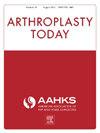Improved Efficiency and Intraoperative Planning With 1 Robot-Assisted Total Knee Arthroplasty System
IF 2.1
Q3 ORTHOPEDICS
引用次数: 0
Abstract
Background
Robotic-assisted total knee arthroplasty (rTKA) has garnered significant interest for its potential to enhance surgical precision and accuracy. However, the adoption of such systems poses concerns, including longer operative times and learning curves, potentially reducing efficiency. This study aimed to evaluate the learning curve associated with the Robotic Surgical Assistant (ROSA) system for rTKA.
Methods
This retrospective review analyzed the first 75 ROSA rTKA procedures performed by each of 2 fellowship-trained arthroplasty surgeons (150 total procedures) at a high-volume institution. Time stamps within the robotic software were recorded for each case, along with tourniquet time. Statistical analyses included descriptive statistics, t-tests, and multilevel regression.
Results
Comparison of each surgeon's first 20 and last 20 cases revealed significant decreases in tourniquet time (61.4-56.7 minutes; P = .0417) and planning time (13.49-6.68 minutes; P = .0078). Landmark femur and tibia times remained stable (P = .6542 and P = .9440). Knee state evaluation time showed a trend of reduction from 9.22 to 7.33 minutes (P = .1335), and resection time from 13.66 to 12.92 minutes (P = .4372). Regression analysis indicated significant reductions in tourniquet time (β = −0.11; P = .0089) and planning time (β = −0.08; P = .0064).
Conclusions
This study demonstrates that execution of ROSA rTKA becomes more efficient over the first 75 cases. The greatest improvement with experience is the time spent on the planning panel, the cognitive portion of the procedure. These data provide surgeons with the confidence that the technical portions of the case are quick to learn and guide industry to focus on teaching effective adjustments on the planning panel.
机器人辅助全膝关节置换术系统提高效率和术中计划
机器人辅助全膝关节置换术(rTKA)因其提高手术精度和准确性的潜力而引起了人们的极大兴趣。然而,采用这种系统会带来一些问题,包括更长的操作时间和学习曲线,可能会降低效率。本研究旨在评估机器人手术助理(ROSA)系统在rTKA中的学习曲线。方法:本回顾性研究分析了一家大容量机构中2名接受过奖学金培训的关节置换外科医生(共150例)分别实施的前75例ROSA rTKA手术。机器人软件记录了每个病例的时间戳,以及止血带的时间。统计分析包括描述性统计、t检验和多水平回归。结果每位外科医生的前20例与后20例比较,止血带时间明显缩短(61.4 ~ 56.7 min;P = 0.0417)和计划时间(13.49 ~ 6.68分钟;P = .0078)。标志性股骨和胫骨时间保持稳定(P = 0.6542和P = 0.9440)。膝关节状态评估时间从9.22分钟缩短至7.33分钟(P = 0.1335),切除时间从13.66分钟缩短至12.92分钟(P = 0.4372)。回归分析显示止血带时间显著缩短(β = - 0.11;P = 0.0089)和计划时间(β = - 0.08;P = .0064)。结论本研究表明,在前75例中,ROSA rTKA的执行效率更高。经验最大的改善是花在计划小组上的时间,这是程序的认知部分。这些数据为外科医生提供了信心,使他们能够快速学习病例的技术部分,并指导行业专注于在计划面板上教授有效的调整。
本文章由计算机程序翻译,如有差异,请以英文原文为准。
求助全文
约1分钟内获得全文
求助全文
来源期刊

Arthroplasty Today
Medicine-Surgery
CiteScore
2.90
自引率
0.00%
发文量
258
审稿时长
40 weeks
期刊介绍:
Arthroplasty Today is a companion journal to the Journal of Arthroplasty. The journal Arthroplasty Today brings together the clinical and scientific foundations for joint replacement of the hip and knee in an open-access, online format. Arthroplasty Today solicits manuscripts of the highest quality from all areas of scientific endeavor that relate to joint replacement or the treatment of its complications, including those dealing with patient outcomes, economic and policy issues, prosthetic design, biomechanics, biomaterials, and biologic response to arthroplasty. The journal focuses on case reports. It is the purpose of Arthroplasty Today to present material to practicing orthopaedic surgeons that will keep them abreast of developments in the field, prove useful in the care of patients, and aid in understanding the scientific foundation of this subspecialty area of joint replacement. The international members of the Editorial Board provide a worldwide perspective for the journal''s area of interest. Their participation ensures that each issue of Arthroplasty Today provides the reader with timely, peer-reviewed articles of the highest quality.
 求助内容:
求助内容: 应助结果提醒方式:
应助结果提醒方式:


